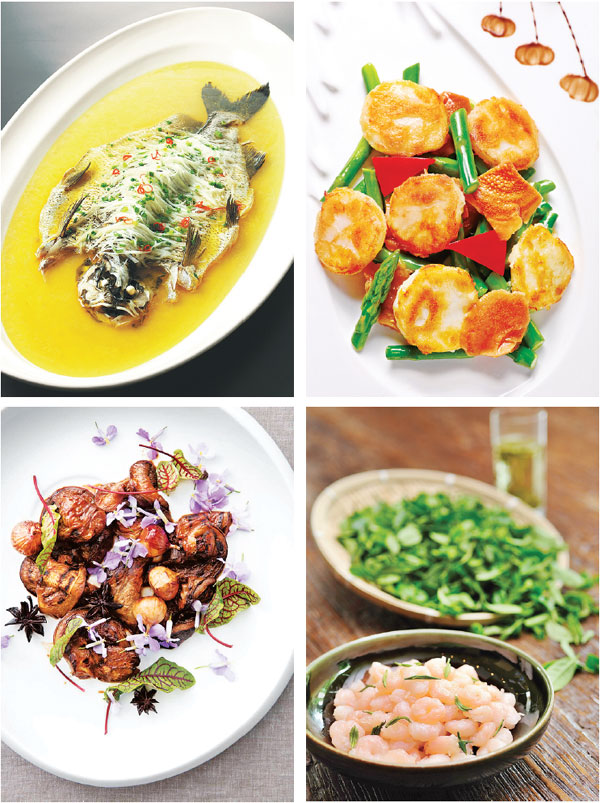French food guide highlights Chinese cuisine
By Xu Lin (China Daily) Updated: 2017-01-21 07:00
|
The delicious dishes from the top Chinese mainland restaurants have been made into La Liste. Photos Provided to China Daily |
Foodies who are eager to sample delicious Chinese food must not miss the newly published book - The Guide to La Liste's Top Chinese Restaurants.
"Foodies may feel lost as there are so many gastronomic lists. But French gastronomic classification La Liste (The list) is known as 'the guide of the guides', and offers relatively authoritative and fair guides," says food and wine critic Xie Ling based in Beijing, one of the book's co-authors. She is better known as her pseudonym Lingxin Xiaoxie.
"The book tells you which Chinese restaurants have won international recognition and what their best dishes are."
La Liste was founded by Philippe Faure in 2015, who is responsible for the Tourism Development Agency of France.
The Chinese language guidebook was published by Qingdao Publishing House and is co-authored by Dong Keping, He Nong and Xie Ling, who were the only Chinese judges on La Liste's international advisory board.
Authorized by La Liste, the book comprises 42 Chinese mainland restaurants, which made it to La Liste 2016's 1,000 outstanding eateries in the world.
La Liste 2016 was unveiled in Paris, December 2015.
Of the restaurants in La Liste 2016, 14 are in Beijing and Tianjin, 13 in Shanghai, eight in Jiangsu and Zhejiang provinces, three in Chengdu, Sichuan province and four in Guangzhou, Guangdong province. The restaurants cover a range of cuisines, including Shanghai and Cantonese food.
When the list was first announced in 2015, many Chinese restaurants had no idea that they had been put on the list. There was also confusion due to translation issues.
The three co-authors aim to promote the restaurants among Chinese foodies through the book with detailed information.
La Liste's international advisory board looks at the dining experience, including food quality, ambience, decor and service.
For La Liste's restaurant guides, the organizer typically looks at reviews of the restaurants by guidebooks, online sites and trusted publications.
The La Liste listings are based on an algorithm where each review is converted into a standard grade, each guidebook is given a trustworthiness score and online customer reviews are also considered.
"This means that restaurants don't know which aspect to focus on in order to be selected. The La Liste ranking is based on many factors. There is different criteria - flavor, service, wine lists," says Xie.
According to Xie, in the past, Westerners learned about Chinese cuisine through Chinese restaurants overseas, many of which are in Chinatowns around the world.
These eateries often localized their fare to cater to local tastes and are different from those based in China.
"But thanks to La Liste, we can now find outstanding Chinese restaurants in China," she says.
Speaking about weaknesses, she says that many Chinese restaurants have problems with their wine menus, but are improving by pairing wines with dishes.
Also, many overseas wineries, wine-producing regions and wine associations are teaching Chinese consumers about pairing wines with Chinese food by holding wine dinners in Chinese restaurants.
Highlighting another issue, she says: "It's not easy to do wine pairing if all dishes are served at the same time. But this is changing with Chinese dining habits being influenced by Western norms."
And as international Chinese cuisine cooking competitions follow international judging criteria, restaurants will learn how to present dishes in sequence - beginning with a starter, followed by a main course and ending with dessert.
She also says that the food and beverage industry in China, especially high-end restaurants are more familiar with La Liste now thanks to promotion of the list over the past year, and she hopes that the new book will help make La Liste more popular among Chinese foodies.
In December 2016, 100 Chinese restaurants from Chinese mainland, Hong Kong, Macao and Taiwan made it to La Liste 2017's top 1,000 eateries worldwide. Among them were 68 restaurants from the Chinese mainland, a jump of 45 percent compared with La Liste 2016.
Many Chinese restaurants on the list also improved their rankings. For instance, the Huai Yang Fu restaurant at Andingmen, in Beijing, was ranked 34 in the new list from 45 in the earlier one.
Xie says that the three co-authors plan to put out a revised version of its Chinese restaurant book based on the new list, which will also include top restaurants from Hong Kong, Macao and Taiwan.
Huai Yang Fu is famous for its Huaiyang cuisine, one of the four major cuisines in China.
Named after Huai'an and Yangzhou, cities in Jiangsu province, the cuisine is characterized by fresh ingredients and light flavors
Luo Yang, the general manager of the restaurant, attributed the restaurant's success to the ingredients and the traditional cooking skills.
For instance, the restaurant use white fish from Taihu Lake.
He also says that the restaurant have introduced the concept of appetizers and desserts. So it is convenient for them to match wines with the food.
xulin@chinadaily.com.cn
- 'Cooperation is complementary'
- Worldwide manhunt nets 50th fugitive
- China-Japan meet seeks cooperation
- Agency ensuring natural gas supply
- Global manhunt sees China catch its 50th fugitive
- Call for 'Red Boat Spirit' a noble goal, official says
- China 'open to world' of foreign talent
- Free trade studies agreed on as Li meets with Canadian PM Trudeau
- Emojis on austerity rules from top anti-graft authority go viral
- Xi: All aboard internet express












